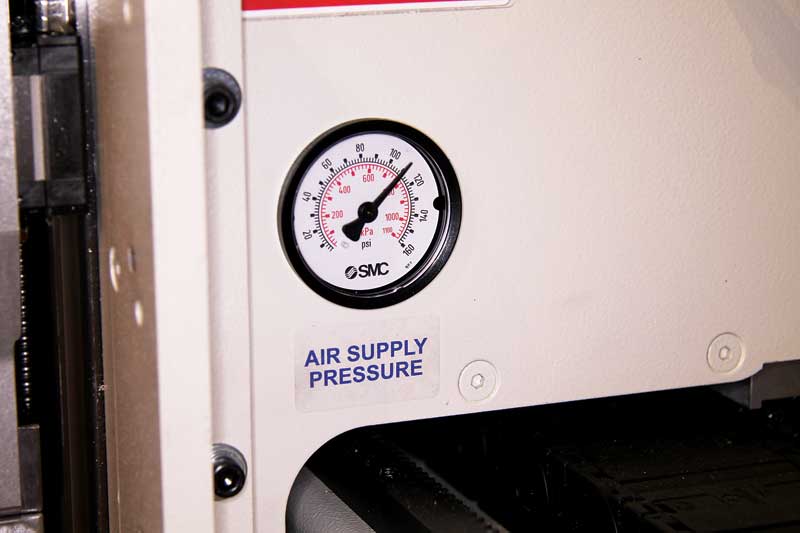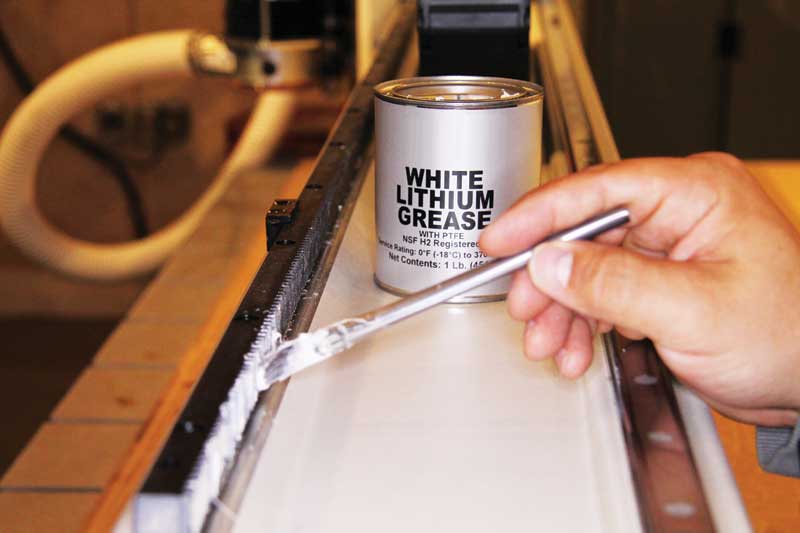
Most CNC routers use pneumatic air that must be clean, dry and maintained at a steady barometric pressure.
There may of course be times when the workload or a customer deadline can hamper adherence to a maintenance schedule, but given the expense of the equipment and the potential for long-term issues, such situations should be avoided if possible. Every maintenance requirement, especially daily lubrication, should be ensured by the shop’s management. There can be no shortcuts or ‘cutting corners’ allowed when it comes to the equipment that is the shop’s very lifeblood.
The process of routine router maintenance, for that matter, is not particularly time-consuming. Greasing the racks and bearings, by way of example, takes only a few minutes. Today’s router technology also simplifies the process, with automated internal logs to update users daily about issues as they are detected, documenting both their history and their resolution. The purpose of such features is to reduce the possibility of unexpected complications that could lead to downtime during a production run.
Given all of the conditions associated with a busy production schedule, it can be easy for staff to miss a step or two. Fortunately, some advanced routers’ databases include an entire maintenance log—i.e. daily, weekly and monthly—to document the date and time of each action, thus verifying the prescribed schedule is being followed at all times. Router manufacturers can even access and send files of each day’s activity to the user at the shop or other facility.
General guidelines
Maintenance schedules tend to vary by specific machine and model, but the following five guidelines apply to all of them:
1. Ensure cleanliness.
It does not take long for CNC routers to get very dirty. Most of them operate in what can be considered a highly dusty environment, which visibly accentuates the need for cleanliness, but buildups of fluids or chips can also easily get into the bearings and controls. This is a sure recipe for problems if it is not corrected every day with cleaning.
Manufacturers generally recommend hand-sweeping of their machines. An air gun can also be used to keep substances away from the bearings. Another fairly standard recommendation is to lower the router’s air pressure during the cleaning process.
2. Change the filters.
Just as clogged filters jeopardize the efficiency of an automobile’s engine, so too must a CNC router’s control box and vacuum pumps be changed on a regular basis, along with the filters that trap oil and water in the pneumatic lines.
As a rule of thumb, all filters should be checked weekly and changed as needed, but there is no standardized schedule. Rather, the frequency of the changes will vary, depending on the specific machine, the types of materials being cut and other environmental factors in the facility, such as dust and dirt.
3. Lubricate.
Despite their many parts, CNC routers do not require extensive lubrication, but breakdowns will be inevitable if the process is not followed as required. And should the failure to lubricate cause a malfunction, there is a real possibility of voiding the manufacturer’s warranty.
Lubrication is so basic a step, no reminders should be necessary—but reminders help emphasize its importance. Bearings, pumps and oscillating knives all need regular lubrication and, again, the maintenance schedule will vary depending on the type of machine, the extent of its use and the environment around it.
4. Keep the air supply clean.
Most CNC routers operate with pneumatic air, which has to be clean, dry and maintained at a steady pressure greater than 552 kPa (80 psi). With the incorrect specifications, damage to the machine is likely in a very short time frame, so the air pressure should be checked regularly.
5. Provide safe and proper electrical power.
As with any electrical machinery, the power supply to a CNC router must be sufficient and safely connected as required under any local power regulations.
Failure is most likely to occur in cases of poor electrical grounding, low voltage or insufficient capacity. Also, as is the case with other computer-operated mechanism, a spike in power can cause serious damage.






